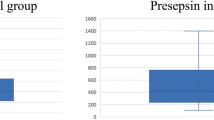Abstract
Purpose
Infectious complication could be life-threatening in patients with chemotherapy-induced febrile neutropenia (FN). The Multinational Association of Supportive Care in Cancer (MASCC) risk-index score is used to predict the complications of these patients, and it has been focused on identifying low-risk patients who may be candidates for outpatient management. In this study, we evaluated procalcitonin (PCT) and the MASCC score in predicting bacteremia and septic shock in patients with FN.
Methods
From November 2010 to October 2011, 355 patients with FN were prospectively enrolled. Clinical and laboratory findings, including procalcitonin, and the MASCC score were analyzed and correlated with the infectious complications of FN.
Results
Of the 355 patients, 35 (9.9 %) had bacteremia, and 25 (7.0 %) developed septic shock. PCT ≥0.5 ng/mL (OR 3.96, 95 % CI 1.51–10.40), platelet count <100 × 103/mm3 (OR 2.50, 95 % CI 1.10–5.66), and MASCC score <21 (OR 2.45, 95 % CI 1.03–5.85) were independently predictive of bacteremia, and PCT ≥1.5 ng/mL (OR 29.78, 95 % CI 9.10–97.39) and MASCC score <21 (OR 9.46, 95 % CI 3.23–27.72) were independent factors of septic shock. In 306 patients with low-risk FN classified by the MASCC score, 52 had PCT ≥0.5 ng/mL and 31 had PCT ≥1.5 ng/mL. Of the 52 patients with PCT ≥0.5 ng/mL, 12 (23.1 %) had bacteremia, and of the 31 patients with PCT ≥1.5 ng/mL, 7 (22.6 %) developed septic shock.
Conclusion
Implicating PCT as a routine use in clinical practice along with the MASCC score could improve risk stratification of patients with FN.



Similar content being viewed by others
References
Klastersky J, Paesmans M, Georgala A, Muanza F, Plehiers B, Dubreucq L, Lalami Y, Aoun M, Barette M (2006) Outpatient oral antibiotics for febrile neutropenic cancer patients using a score predictive for complications. J Clin Oncol 24:4129–4134
Hui EP, Leung LK, Poon TC, Mo F, Chan VT, Ma AT, Poon A, Hui EK, Mak SS, Lai M, Lei KI, Ma BB, Mok TS, Yeo W, Zee BC, Chan AT (2011) Prediction of outcome in cancer patients with febrile neutropenia: a prospective validation of the Multinational Association for Supportive Care in Cancer risk index in a Chinese population and comparison with the Talcott model and artificial neural network. Support Care Cancer 19:1625–1635
Uys A, Rapoport BL, Fickl H, Meyer PW, Anderson R (2007) Prediction of outcome in cancer patients with febrile neutropenia: comparison of the Multinational Association of Supportive Care in Cancer risk-index score with procalcitonin, C-reactive protein, serum amyloid A, and interleukins-1beta, -6, -8 and -10. Eur J Cancer Care (Engl) 16:475–483
Klastersky J, Paesmans M, Rubenstein EB, Boyer M, Elting L, Feld R, Gallagher J, Herrstedt J, Rapoport B, Rolston K, Talcott J (2000) The Multinational Association for Supportive Care in Cancer risk index: a multinational scoring system for identifying low-risk febrile neutropenic cancer patients. J Clin Oncol 18:3038–3051
Klastersky J, Ameye L, Maertens J, Georgala A, Muanza F, Aoun M, Ferrant A, Rapoport B, Rolston K, Paesmans M (2007) Bacteraemia in febrile neutropenic cancer patients. Int J Antimicrob Agents 30(Suppl 1):S51–S59
Persson L, Engervall P, Magnuson A, Vikerfors T, Soderquist B, Hansson LO, Tidefelt U (2004) Use of inflammatory markers for early detection of bacteraemia in patients with febrile neutropenia. Scand J Infect Dis 36:365–371
Giamarellos-Bourboulis EJ, Grecka P, Poulakou G, Anargyrou K, Katsilambros N, Giamarellou H (2001) Assessment of procalcitonin as a diagnostic marker of underlying infection in patients with febrile neutropenia. Clin Infect Dis 32:1718–1725
Ahn S, Lee YS, Chun YH, Lim KS, Kim W, Lee JL (2012) Predictive factors of bacteraemia in low-risk patients with febrile neutropenia. Emerg Med J 29:715–719
Hughes WT, Armstrong D, Bodey GP, Bow EJ, Brown AE, Calandra T, Feld R, Pizzo PA, Rolston KV, Shenep JL, Young LS (2002) 2002 guidelines for the use of antimicrobial agents in neutropenic patients with cancer. Clin Infect Dis 34:730–751
Engel A, Steinbach G, Kern P, Kern WV (1999) Diagnostic value of procalcitonin serum levels in neutropenic patients with fever: comparison with interleukin-8. Scand J Infect Dis 31:185–189
Hambach L, Eder M, Dammann E, Schrauder A, Sykora KW, Dieterich C, Kirschner P, Novotny J, Ganser A, Hertenstein B (2002) Diagnostic value of procalcitonin serum levels in comparison with C-reactive protein in allogeneic stem cell transplantation. Haematologica 87:643–651
Schuttrumpf S, Binder L, Hagemann T, Berkovic D, Trumper L, Binder C (2006) Utility of procalcitonin concentration in the evaluation of patients with malignant diseases and elevated C-reactive protein plasma concentrations. Clin Infect Dis 43:468–473
Ahn S, Lee YS (2012) Predictive factors for poor prognosis febrile neutropenia. Curr Opin Oncol 24:376–380
Paesmans M, Klastersky J, Maertens J, Georgala A, Muanza F, Aoun M, Ferrant A, Rapoport B, Rolston K, Ameye L (2011) Predicting febrile neutropenic patients at low risk using the MASCC score: does bacteremia matter? Support Care Cancer 19:1001–1008
Feld R (2008) Bloodstream infections in cancer patients with febrile neutropenia. Int J Antimicrob Agents 32(Suppl 1):S30–S33
Ha YE, Song JH, Kang WK, Peck KR, Chung DR, Kang CI, Joung MK, Joo EJ, Shon KM (2011) Clinical factors predicting bacteremia in low-risk febrile neutropenia after anti-cancer chemotherapy. Support Care Cancer 19:1761–1767
Acknowledgments
We thank Jin Ahn, NP, for her assistance with the English language.
Conflict of interest
None
Author information
Authors and Affiliations
Corresponding author
Rights and permissions
About this article
Cite this article
Ahn, S., Lee, YS., Lim, K.S. et al. Adding procalcitonin to the MASCC risk-index score could improve risk stratification of patients with febrile neutropenia. Support Care Cancer 21, 2303–2308 (2013). https://doi.org/10.1007/s00520-013-1787-6
Received:
Accepted:
Published:
Issue Date:
DOI: https://doi.org/10.1007/s00520-013-1787-6




